Automated ablation of dental composite using an IR pulsed laser coupled to a plume emission spectral feedback system
Abstract
Objective
The purpose of this study is to assemble a laser system for the selective removal of dental composite from tooth surfaces, that is feasible for clinical use incorporating a spectral feedback system, a scanning system, articulating arm and a clinical hand-piece, and evaluate the performance of that system on extracted teeth.
Methods
Ten extracted teeth were collected and small fillings were placed on the occlusal surface of each tooth. A clinical system featuring a CO2 laser operating at 50 Hz and spectral optical feedback was used to remove the composite. Removal was confirmed using a cross polarized optical coherence tomography (CP-OCT) system designed for clinical use.
Results
The system was capable of rapidly removing composite from small preparations on tooth occlusal surfaces with a mean loss of enamel of less than 20 μm.
Conclusion
We have demonstrated that spectral feedback can be successfully employed in an automated system for composite removal by incorporating dual photodiodes and a galvanometer controlled CO2 laser. Additionally, the use of registered OCT images presents as a viable method for volumetric benchmarking. Overall, this study represents the first implementation of spectral feedback into a clinical hand-piece and serves as a benchmark for a future clinical study. Lasers Surg. Med. 49:658–665, 2017. © 2017 Wiley Periodicals, Inc.




